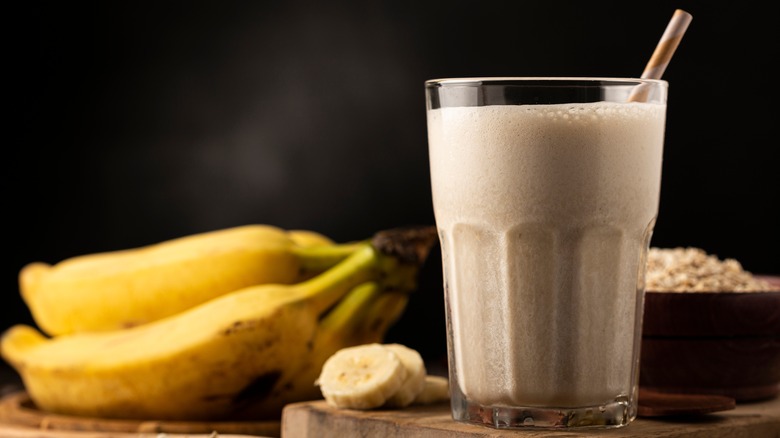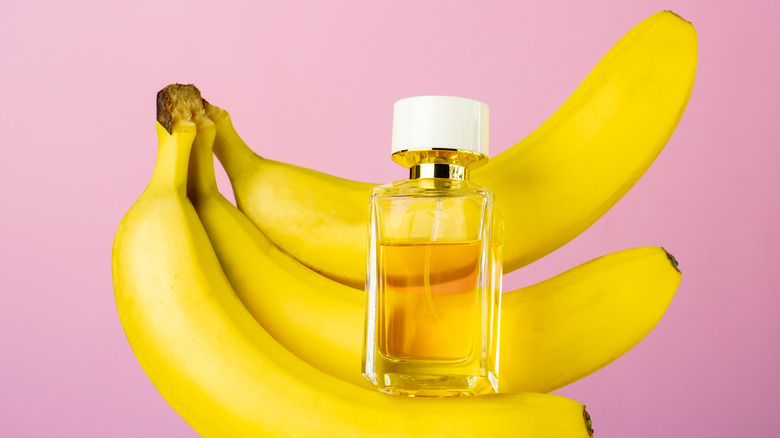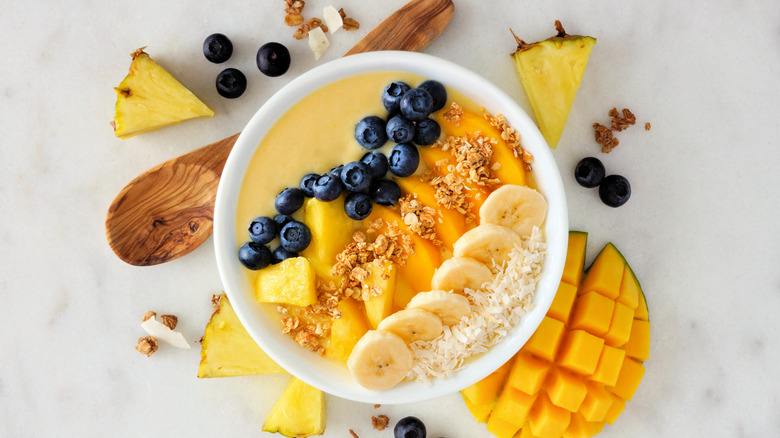The Science Behind Why Bananas Take Over Your Smoothie Every Time
From the lingering aroma in your lunchbox to the unmistakable scent that greets you as you open your trash can, the smell of bananas and their peels has staying power. This is also true with smoothies — if you've ever made a strawberry-banana smoothie, only to have it come out tasting mostly of banana, you can blame banana chemistry. Yep, bananas don't just have a strong personality, they have an interesting chemical profile thanks to a specific ester. (No, not a person named Esther.)
Esters are chemical compounds (usually pleasant) that give many foods their signature smell and by proxy, flavor. One of the main esters found in bananas is called isoamyl acetate, which works hard to ensure that bananas are always the center of attention. As it turns out, the reason behind this has to do with a banana adaptation, and to counteract its effects, you'll need a mini science lesson.
Meet isoamyl acetate, aka banana perfume
Although the science of esters like isoamyl acetate can be complex, you don't need to dive too deep into your old chemistry textbook to understand how they work. On a basic level, esters are made up of carbon, hydrogen, and oxygen in a defined configuration, and are made when an acid reacts with alcohol. They include everything from the pineapple aroma of ethyl butanoate to ethyl formate, which smells like rum.
When it comes to bananas (which are actually berries), acids and alcohol are naturally present in the fruit. As the banana ripens, enzymes break these molecules down and form esters like isoamyl acetate. This process continues with ripening, which forms more esters and intensifies the flavor and aroma. Interestingly, isoamyl alcohol can also be found in some beers and is formed when yeast breaks down acids and alcohol during the fermentation process.
Beyond flavor, esters also have a role in nature; they emit strong odors that attract pollinators that help plants reproduce. High levels of smelly isoamyl acetate were found in Gros Michel bananas, which are now mostly extinct thanks to a fungal plague that wiped the species out in the early 1900s, and were the original inspiration for banana-flavored candy that (some of us) still enjoy today. Now, we have Cavendish bananas, which are a bit different from their earlier cousins.
How to mask or enhance banana flavor with science
Cavendish bananas have a slightly different ester profile than their predecessors, with less isoamyl acetate and a balance of other scent-producing compounds, making their flavor less pronounced. However, since the taste detection threshold for isoamyl acetate is so low compared to other fruit flavors, they can still overpower a dish, especially smoothies.
If you want to embrace the banana flavor in your smoothie, it's easy to highlight its robust flavor profile with peanut butter, chocolate, oats, or cinnamon. You can also do a little science experiment by mixing other fruits (and their esters) to form new flavor compounds –– for example, blending pineapple, orange, grape, and pear will produce pentyl acetate, an ester that is reminiscent of banana.
To tone down the banana in your smoothie instead, mix in other bold fruit flavors like pineapple, mango, and coconut. You can also use the science of banana ripening to your advantage and use a less ripe banana, which you can ensure by using a bit of plastic wrap when you store them. But whatever you do, if you're banana flavor averse, don't use a Gros Michel.


